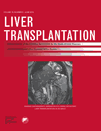Early transplanted liver performance and indocyanine green clearance
We thank Stockmann and colleagues for their interesting comments about our article.1 We particularly appreciate this because of their extensive experience in the field.
We agree about the disadvantages of the classification that we used to evaluate graft function. Unfortunately, up to now, there has been no test or score that on its own allows an early diagnosis of graft function that can be used as a reference standard in trials of diagnostic accuracy. According to the Standards for Reporting of Diagnostic Accuracy initiative, the reference standard is considered to be the best available method for establishing the presence or absence of the condition, and this includes dedicated clinical follow-up of patients.2 In our study,1 the limitations of the use of the Greig classification, which we discussed, were overcome by the information obtained from the clinical follow-up of the patients. We compared the patients with severe graft dysfunction (SGD; grade IV of the Greig classification) to the other patients. All 10 patients classified with SGD underwent retransplantation (6 cases) or died while they waited for a new graft (4 cases). On the other hand, no patient with grade III function or lower grade function needed emergency retransplantation. The fact that SGD was associated with such a clinically relevant outcome adds further support to our results. Interestingly, the indocyanine green plasma disappearance rate (PDR) had higher sensitivity, specificity, and area under the receiver operating characteristic curve values for predicting SGD than aspartate aminotransferase, international normalized ratio, or bilirubin values. Furthermore, the PDR cutoff point identified in our study also predicted survival. Patients with a PDR below 10.8%/minute, even when it was measured 1 hour after reperfusion, had a lower survival rate than the rest of the sample (53%, 47%, and 47% versus 95%, 94%, and 90% at 3, 6, and 12 months respectively), especially because of the early mortality related to SGD. Similar results were observed with the PDR measured within the first 24 hours after liver transplantation. We believe that these clinically relevant outcomes add robustness to our results.
As Stockmann and colleagues stated, PDR depends on liver perfusion, sinusoidal uptake, adenosine triphosphate–dependent excretion, and biliary drainage. Any severe alteration in one of these factors could lead to a low PDR. Therefore, low values of PDR can alert us to the presence of complications before other tests, although we may not distinguish between severe vascular complications and primary nonfunction. In this case, special care should be taken to identify any potentially reversible complications, particularly vascular problems; this can lead to early resolution of these issues. We hope that the early resolution of complications will improve the outcome.
We have read with interest the recent article published by Stockmann and colleagues3 about the use of a novel test, LiMAx, to predict initial graft dysfunction. Interestingly, this test is based on the administration of C-methacetin: C-methacetin is metabolized in the hepatocytes by the cytochrome p450 1A2 system, and then its byproduct is measured in the exhaled air as 13CO2. On the other hand, indocyanine green is passively introduced into the hepatocytes and then is actively eliminated into the bile by an adenosine triphosphate–mediated mechanism. Because the liver is complex and neither test is particularly expensive, perhaps a combination of the 2 tests could better reflect what is happening in the liver and offer the best predictive value.
REFERENCES
Luis Olmedilla*, Cristina Ripoll , José-María Pérez-Peña*, Ignacio Garutti*, Rafael Bañares , * Service of Anesthesia and Reanimation, Madrid, Spain, Hepatology and Liver Transplant Unit, and Centro de Investigaciǒn Biomédica en Red de Enfermedades Hepáticas y Digestivas Hospital General Universitario Greforio Marañón, Madrid, Spain.




